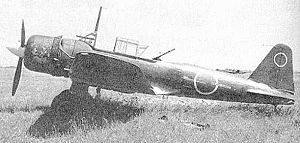Mitsubishi Ki-51 Video - Picture

|
|
Mitsubishi Ki-51
Ki-51

Picture - Mitsubishi Ki-51
Role: Type 99 Attacker
Manufacturer: Mitsubishi
First flight: mid-1939
Primary user: Imperial Japanese Army Air Force
Number built: 2385
The Mitsubishi Ki-51 (Army designation "Type 99 Assault Plane". Allied nickname "Sonia") was a light bomber/dive bomber in service with the Imperial Japanese Army during World War II. It first flew in mid-1939. Initially deployed against Chinese forces, it proved to be too slow to hold up against the fighter aircraft of the other Allied powers. However, it performed a useful ground-attack role in the China-Burma-India theatre, notably from airfields too rough for many other aircraft. As the war drew to a close, they began to be used in kamikaze attacks. Total production was around 2,385 units.
Charles Lindbergh, flying a P-38 Lightning shot down a Ki-51 after a vigorous dogfight in which the much slower Ki-51 utilized its low speed maneuverability and made a fight of it.
Versions
Prototypes: 2 built
Service trials: 11 built
Ki-51: 2,3721 built (Manufacturers: Mitsubishi (1,462), Tachikawa Army Air Arsenal (913))
Ki-71 Prototypes: 3 built (Manufacturer: Tachikawa Army Air Arsenal) Version with retractable undercarriage
Operators
Japan
Imperial Japanese Army Air Force
Indonesia
In 1945, Indonesian People's Security Force (IPSF) (Indonesian pro-independence guerrillas) captured a small number of aircraft at numerous Japanese air bases, including Bugis Air Base in Malang (repatriated 18 September 1945). Most aircraft were destroyed in military conflicts between the Netherlands and the newly proclaimed-Republic of Indonesia during the Indonesian National Revolution of 1945-1949.
China
Communist Chinese (captured): The last 4 Ki-51s retired in 1953.
Survivors
The only surviving Ki-51 is on display on Adisucipto International Airport.
Specifications (Ki-51)
Data from Japanese Aircraft of the Pacific War
General characteristics
Crew: Two
Length: 9.21 m (30 ft 2â
in)
Wingspan: 12.1 m (39 ft 8â
in)
Height: 2.73 m (8 ft 11½ in)
Wing area: 24.0 m² (259 ft²)
Empty weight: 1,873 kg (4,129 lb)
Loaded weight: 2,798 kg (6,169 lb)
Max takeoff weight: 2,920 kg (6,415 lb)
Powerplant: 1x Mitsubishi Ha-26-II 14 cylinder air cooled radial engine, 709 kW (950 hp)
Performance
Maximum speed: 424 km/h (229 kn, 263 mph)
Range: 1,060 km (574 nmi, 660 mi)
Service ceiling: 8,270 m (27,130 ft)
Wing loading: 117 kg/m² (23.8 lb/ft²)
Power/mass: 0.24 kW/kg (0.15 hp/lb)
Climb to 5,000 m (16,400 ft): 9 min 55 sec
Armament
Guns:
2x fixed, forward-firing 7.7 mm (.303 in) Type 89 machine guns (replaced with 2x 12.7 mm (.5 in) Ho-103 machine guns in later models)
1x 7.7 mm (.303 in) Te-4 Machine gun rearward-firing machine gun.
Bombs: 200 kg (441 lb) bombs (normal operations); 250 kg (551 lb) for suicide operations
Comparable aircraft
Junkers Ju 87
Bibliography
Francillon, Ph.D., René J. Japanese Aircraft of the Pacific War. London: Putnam & Company Ltd., 1970. ISBN 0-370-00033-1 (2nd edition 1979, ISBN 0-3702-30251-6).
Mitsubishi Ki-51 Pictures
Living Warbirds: The best warbirds DVD series.
Source: WikiPedia